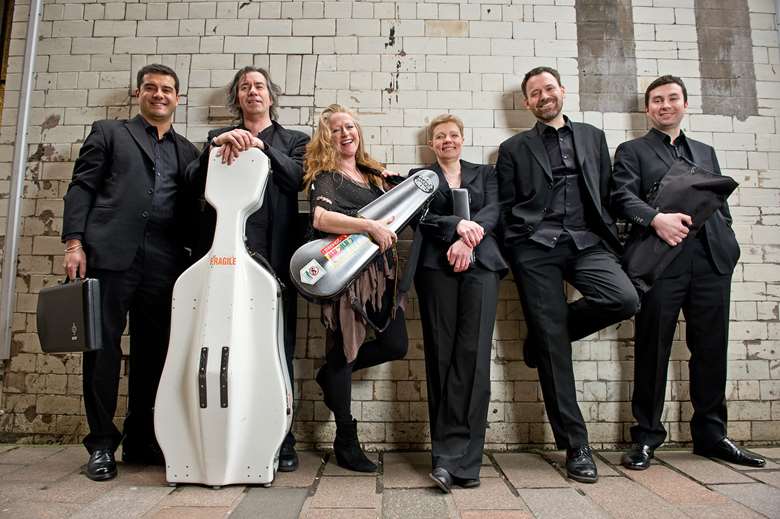Contemporary music for the socially conscious: Red Note Ensemble
Susan Nickalls
Friday, June 4, 2021
Red Note Ensemble brings contemporary music to communities in Scotland and beyond. Susan Nickalls reports

(c) Wattie Cheung
This article first appeared in the August 2019 issue of Classical Music.
How Red Note Ensemble first started might be an apocryphal story but it’s worth telling nevertheless. According to chief executive John Harris, the impetus came in 2008 from his co-artistic director, cellist Robert Irvine. ‘Robert phoned me and said, "I’m really bored, can we start a contemporary music ensemble?" I’d enjoyed working with him in Paragon all those years ago as Robert has a magic touch when it comes to bringing good people together; everyone he asks to work with him says yes. I thought it was a cool idea so we set up the company in 2009.’
As for the name, Irvine had had to come up with one for a Delphian recording project the previous year and the violinist working with the ensemble at the time, Greg Lawson, suggested Red Note. This is taken from Sibelius notation software which highlights the notes you can’t play in red, explains Harris. ‘Red Note plays the difficult notes even if Sibelius can’t. And although we’re not an overly political organisation, the colour red does reflect our socially active ethos. We might play all over Europe but our fundamental grassroots are in community engagement; this is the beating heart of what we do.’
For their outreach work, Red Note embeds itself in a community for three or four years, building up relationships, starting with that community’s primary schools. Usually they choose the locations by looking at a map of Scotland and deciding where the group could be most effective. However, their work in Easterhouse, one of the most deprived areas of Scotland, came about through Celia Duffy, Red Note chair, who met Oakwood primary school’s headteacher at a pottery class. After two years, Harris says the school is now a little vision of heaven.
Looking ahead, Harris is keen to refocus the group’s activities on open access. As well as the ensemble’s three-year community projects in five communities across Scotland, he’s reintroducing Noisy Nights, the informal open mic night for composers. ‘We’re rethinking, rather than reinventing, it by going back to the socially conscious vision of what contemporary music is and can be. We put Noisy Nights to one side for a while because we were knackered and ended up working with the same people over and over and not necessarily reaching a wider audience. We’re not going back to the Traverse and we’re still deciding whether to use the same place or move it around. Having a base has its advantages but we want to remain accessible.’
‘We’re rethinking, rather than reinventing, it by going back to the socially conscious vision of what contemporary music is and can be
Furthermore, Harris points out that whether they’re playing at a primary school in Easterhouse or the Concertgebouw, there is no difference in the music they perform or how they communicate to the audience; everything is interlinked. ‘For the Oakwood Songbook project with composer Brian Irvine, every class came up with the words and the tunes. The songs were given pretty full-on contemporary music arrangements so they weren’t easy listening. We play Lutosławski to five year olds and have taken students from the Royal Conservatoire of Scotland to primary and secondary schools in Easterhouse to talk about their music. The level of engagement is incredibly high. We’re now working towards a big community opera with Brian in Easterhouse, gathering the tendrils of creativity from within these communities to make something new.’
And with the advent of streaming, Harris is keen to introduce more composer development work earlier in the calling for scores process of Noisy Nights through open online forums. For instance, at a designated time, a composer can ask Robert a question online about writing music for the cello before they submit their work.
Reaching as many people as possible is what drives the ensemble’s social engagement programme and like many music groups, Harris is keen to find out why people don’t come to concerts rather than why they do come. Using an audience researcher he was surprised to discover that there is a massive audience for complex exploratory work but people were put off by the concert hall environment where they don’t feel welcome or at home.
‘The reasons were all social, nothing to do with the music. We’ve ballsed it up by creating buildings and places where people don’t feel welcome. It’s not the music itself, it’s the social side that’s the issue, so we need to place ourselves in situations where the music becomes accessible rather than hiding ourselves away. One of the things about Red Note is you don’t have to cross our threshold, we’ll cross yours. We’ll play outside a shopping centre or in an old people’s home. It’s incredibly important that it’s us going to them.’